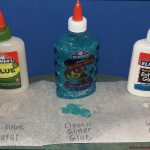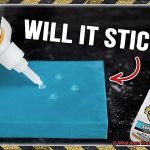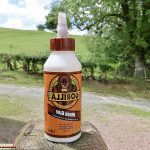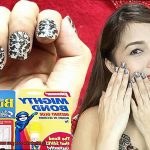Ever had that moment of desperation when you desperately needed an adhesive superhero, only to realize your reliable sidekick, Krazy Glue, just won’t do the trick? This glue is renowned for its Herculean strength, capable of bonding almost anything in its path.
But hold on tight, because there are a few sneaky exceptions that laugh in the face of Krazy Glue’s sticking power.
In this mind-blowing blog post, we’re diving headfirst into the mysterious realm of objects and substances that defy the indomitable grip of this legendary glue. Buckle up as we unravel the jaw-dropping truth about what Krazy Glue simply cannot stick to.
What is Krazy Glue?
Contents
Krazy Glue, a popular brand of adhesive, is a go-to choice for many projects due to its fast-acting and strong bonding capabilities. However, like any adhesive, it has its limitations. Understanding these limitations is crucial when selecting the right adhesive for your specific needs.
One material that may pose a challenge for Krazy Glue is polyethylene and polypropylene plastics. These plastics have low surface energy, making it difficult for adhesives to form a strong bond. To bond these types of plastics effectively, it is recommended to use adhesives specifically designed for them.
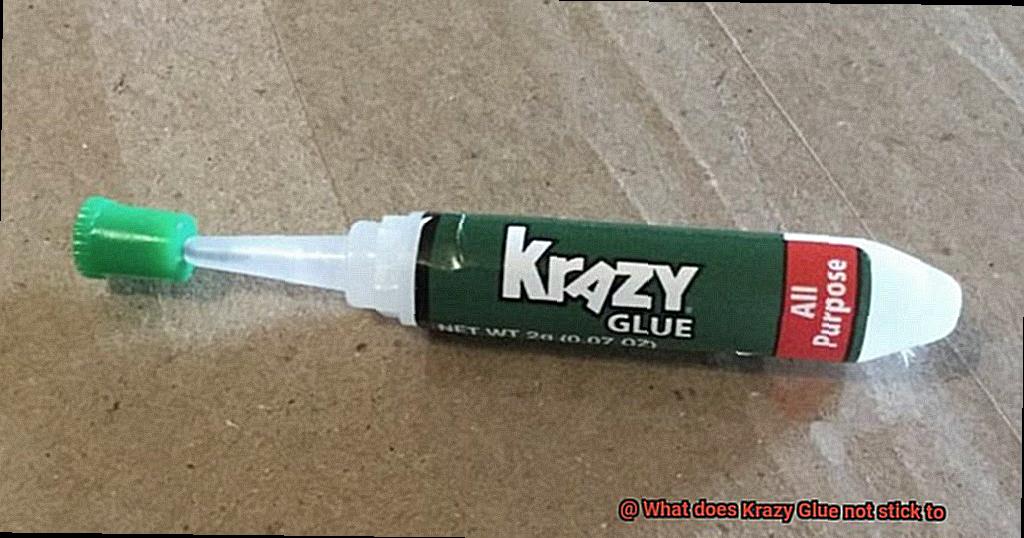
Silicone surfaces can also be tricky for Krazy Glue to adhere to. Silicone’s non-stick properties make it challenging for adhesives to bond with. If you need to bond silicone, it is best to use an adhesive formulated specifically for this material.
Teflon is another material that may resist Krazy Glue’s bonding capabilities. Teflon has a low surface energy and high resistance to chemical bonding. To bond Teflon surfaces successfully, explore alternative adhesives designed specifically for this material.
Certain rubber surfaces may also present difficulties for Krazy Glue. Some rubbers contain additives or coatings that prevent effective adhesion. For rubber projects, consider using specialized rubber adhesives formulated for excellent bonding strength.
Porous materials like fabric or wood may not be suitable for bonding with Krazy Glue because the glue might not penetrate the pores effectively. For these materials, it is advisable to use adhesives designed for porous surfaces.
In addition to material limitations, factors such as surface cleanliness, temperature, and humidity can affect the effectiveness of Krazy Glue. Properly preparing the surfaces and following the instructions on the product packaging will enhance adhesion.
Materials That Krazy Glue May Struggle to Stick To
Krazy Glue, the superhero adhesive loved by many, does have its limitations when it comes to certain materials. Let’s take a closer look at these materials that may pose challenges for Krazy Glue and explore alternative adhesive options that can save the day.
First on our list are non-porous surfaces, those shiny foes like glass, metal, and plastic. Although Krazy Glue can still create a bond on these surfaces, it may not be as strong or long-lasting compared to its performance on porous materials. So if you’re working with these materials, consider alternative adhesives tailored for non-porous surfaces.
Next up are wet or oily surfaces – the rainstorms in the world of adhesives. Moisture and oils act as barriers between the glue and the material, making it difficult for them to bond effectively. To improve your chance of success, make sure to dry or clean the surface before applying Krazy Glue.
Flexibility is another challenge for our superhero adhesive. Materials like rubber or silicone love to stretch and bend, which can compromise the strength of the bond formed by Krazy Glue. Fear not. There are other adhesives out there specifically designed for flexible materials that can save the day.
Heat is another nemesis for Krazy Glue. While it’s generally heat-resistant, extreme temperatures can weaken its bond. So if your project is going to be subjected to high temperatures, seek out an adhesive formulated for such conditions to ensure your hard work doesn’t melt away.
Ah, plastics – they come in all shapes, sizes, and bonding difficulties. While Krazy Glue can handle most plastics, there are some types that it may struggle to adhere to. Polyethylene and polypropylene, in particular, are low surface energy plastics known for their bonding challenges. Luckily, there are specialized adhesives designed specifically for these plastic foes.
Lastly, porous materials with loose fibers can be a challenge for Krazy Glue. While it’s usually great with porous surfaces, those with loose or fibrous textures can pose difficulties. The glue may seep into the fibers or pores, saturating them and weakening the bond. In these cases, alternative adhesives might be the way to go.
Remember, these limitations are just a small part of Krazy Glue’s story. It’s still a fantastic adhesive for many applications. But when it comes to these challenging materials, it’s always good to know your options and explore alternative adhesives tailored to their needs.
Polyethylene and Polypropylene Plastics
When it comes to adhesive bonding, not all materials are created equal. Two common plastics, polyethylene and polypropylene, present a unique challenge due to their low surface energy and non-polar nature. In this article, we will explore the reasons behind why these plastics are difficult to bond and discover specialized adhesives that can overcome these challenges.
The Low Surface Energy Conundrum:
Polyethylene and polypropylene plastics have a low surface energy, meaning that the molecules on their surface lack attraction. This characteristic gives these plastics their excellent resistance to chemicals, moisture, and UV radiation. However, it also makes it challenging for adhesives like Krazy Glue to establish a strong bond.
The Non-Polar Nature:
Another hurdle in bonding polyethylene and polypropylene is their non-polar nature. These plastics lack polar groups or charges that promote strong intermolecular forces required for effective adhesive bonding. Krazy Glue, being a cyanoacrylate adhesive, relies on these forces for adhesion.
Specialized Adhesives to the Rescue:
Fortunately, there are specialized adhesives available that are specifically designed for bonding polyethylene and polypropylene plastics. These adhesives incorporate additives or primers that increase the surface energy of the plastics, enabling better adhesion. They offer tailored solutions to overcome the challenges posed by these low-energy materials.
Silicone and Teflon Surfaces
It can be frustrating, but fear not. In this article, we’ll dive into the fascinating world of silicone and Teflon surfaces and uncover why Krazy Glue struggles to adhere to them.
The Non-Stick Nature of Silicone:
Silicone, with its low surface energy, is well-known for its non-stick properties. This makes it perfect for kitchen utensils, medical devices, and more. However, this very quality also poses a challenge for adhesive bonding.
Beading Up and Sliding Off:
Krazy Glue tends to bead up or slide off silicone surfaces due to their low surface energy. Imagine trying to glue two pieces together while they’re covered in tiny water droplets – the adhesive just can’t get a grip.
Temporary Bonding Advantage:

The lack of adhesion between Krazy Glue and silicone can be advantageous. If you need a temporary bond without residue or damage, Krazy Glue’s inability to stick permanently can be quite helpful.
The Tough Nut: Teflon:
Teflon, also known as PTFE, is another material famous for its non-stick properties. From cookware to industrial applications, Teflon’s low surface energy and non-porous nature make it a formidable opponent for adhesives like Krazy Glue.
A Smooth Surface Challenge:
Krazy Glue finds it difficult to penetrate the smooth surface of Teflon due to its low surface energy. Bonding becomes weak or temporary at best. But fear not. Removal methods exist if you accidentally get Krazy Glue on a Teflon-coated object.
Solvent Solutions:
Removing Krazy Glue from Teflon can be achieved by gently scraping it off with a plastic tool or using solvents designed for adhesive residues. So even if it does stick temporarily, there’s always a way to undo the bond.
Certain Types of Rubber
Crafting and DIY projects often require a strong adhesive like Krazy Glue. However, it’s important to understand that not all types of rubber will effectively adhere to this adhesive. In this blog post, we will delve into the reasons why Krazy Glue may struggle to bond with certain rubber surfaces and explore alternative options for successful adhesion.
Silicone Rubber:
Silicone rubber is renowned for its flexibility, durability, and resistance to high temperatures. These desirable properties, however, create challenges for Krazy Glue. Silicone rubber possesses a low surface energy and is non-porous, resulting in a smooth and slippery surface that prevents adhesives like Krazy Glue from forming a strong bond.
EPDM Rubber:
EPDM rubber is widely used in automotive applications due to its exceptional resistance to weathering and UV radiation. However, this type of rubber can pose difficulties for Krazy Glue. The chemical composition of EPDM rubber makes it resistant to adhesion by certain types of adhesives, including Krazy Glue.
Natural Rubber or Latex Rubber:
Derived from the sap of rubber trees, natural rubber or latex rubber is commonly found in gloves, balloons, and elastic bands. Despite its many beneficial properties, natural rubber may not bond strongly with Krazy Glue. Similar to silicone rubber, natural rubber has a low surface energy that hampers effective adhesion by most adhesives.
Specialized Rubber Adhesives:
When bonding rubber materials together, it is essential to explore alternative adhesive options specifically designed for this purpose. Specialized rubber adhesives available on the market offer improved adhesion and flexibility properties that enable effective bonding with various types of rubber surfaces. These adhesives are specifically formulated to overcome the challenges posed by certain rubbers.
Surface Preparation:
To enhance the bond strength between Krazy Glue and rubber surfaces, proper surface preparation is crucial. Ensuring that the rubber surface is clean and free from oils or contaminants that hinder adhesion is recommended. Additionally, lightly sanding or roughening the surface of the rubber before applying Krazy Glue can create a stronger bond by providing more surface area for the adhesive to adhere to.
Porous Materials such as Fabric or Wood
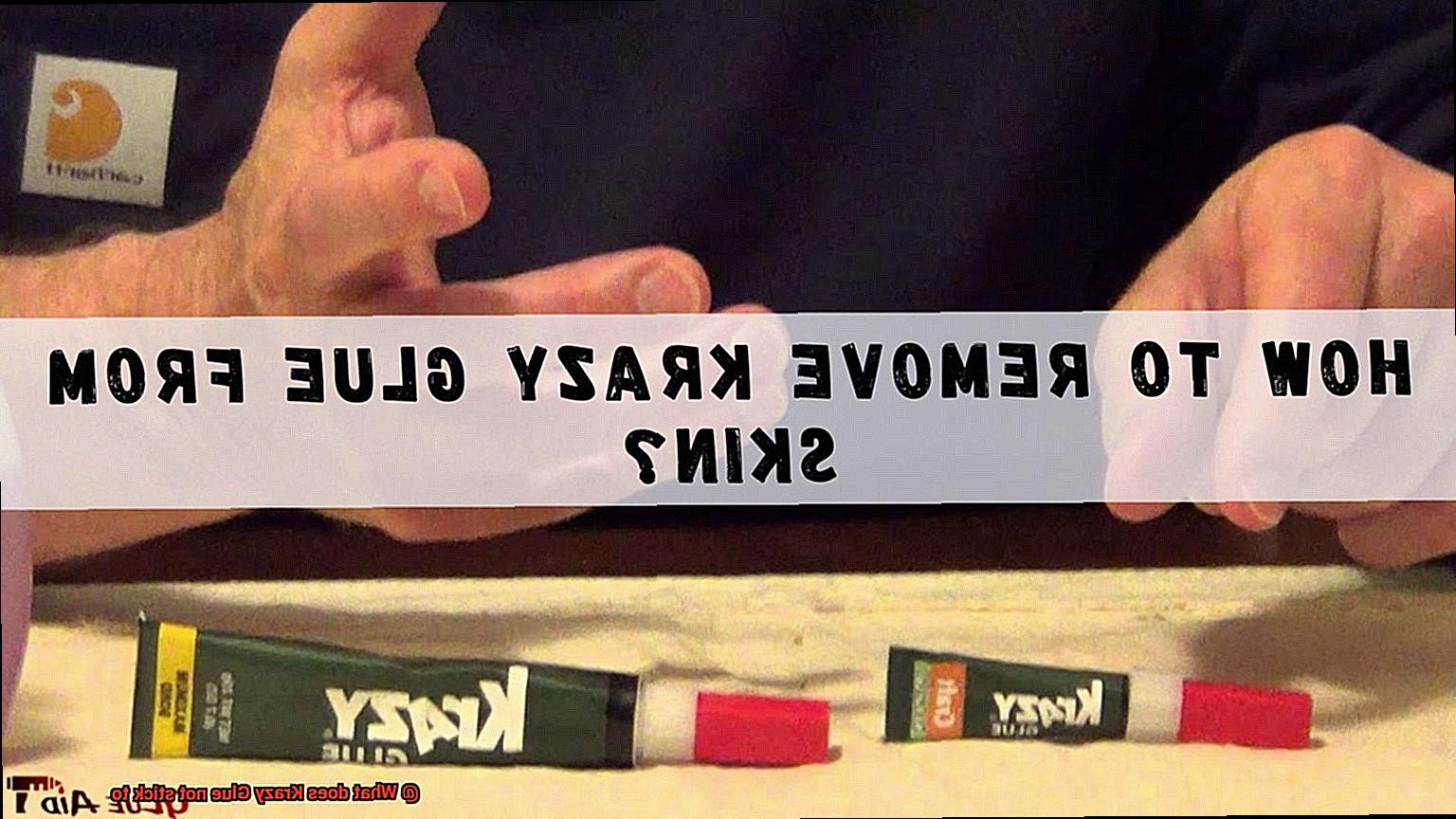
Porous materials, such as fabric and wood, possess a captivating array of characteristics that set them apart from other surfaces. These materials contain intricate networks of tiny holes and gaps, allowing for the passage of air and liquids. However, when it comes to bonding these porous surfaces, traditional adhesives like Krazy Glue may fall short. In this article, we will delve into the limitations of Krazy Glue and explore alternative adhesives specifically designed to conquer the challenges posed by fabric and wood.
The Enigma of Porous Materials:
Fabric and wood are fascinating examples of porous materials. Their unique structures give rise to remarkable properties that can be both beneficial and challenging when it comes to adhesion.
The Knotty Issue of Fabric:
Fabrics, with their tightly woven fibers, present a daunting task for traditional adhesives like Krazy Glue. The intricate nature of these fibers makes it difficult for the glue to penetrate through the surface and establish a strong bond. Additionally, smooth fabrics such as cotton or silk pose an additional obstacle, as their sleek surfaces further diminish the adhesive capabilities of Krazy Glue.
Wood’s Intricate Pores:
Wood, a natural material cherished for its beauty and versatility, is characterized by its porosity. The numerous pores scattered throughout its texture can absorb adhesives like Krazy Glue, preventing them from forming a robust bond on the surface. Moreover, the moisture content within the wood can interfere with the curing process of Krazy Glue, ultimately weakening its adhesive strength.
A World of Specialized Adhesives:
Fortunately, there are alternative adhesives available that are tailor-made for bonding porous materials such as fabric or wood. Fabric glues are specially formulated to effectively penetrate fabrics, creating flexible and washable bonds that withstand the test of time. Meanwhile, wood glues offer superior strength and reliability compared to Krazy Glue, ensuring a lasting bond for various woodworking projects.
Selecting the Perfect Adhesive:
When selecting an adhesive for porous materials, it is crucial to consider the specific requirements of each material. For fabrics, opt for a fabric glue that offers flexibility and washability while accommodating various fabric types. When working with wood, choose a wood glue that provides exceptional bonding strength and is suitable for the particular wood species and moisture content.
Factors that Affect Adhesion
Adhesion, the ability of a substance to stick or bond to another surface, is influenced by several factors. To understand how adhesion works, let’s dive deep into the world of glues and uncover the key elements that determine their sticking power.
First and foremost, surface type plays a crucial role in adhesion. Smooth and non-porous surfaces like glass, ceramics, metals, and certain plastics are a match made in adhesive heaven. These materials provide a solid foundation for glue to form strong bonds. On the other hand, porous surfaces like wood or fabric present a challenge. The glue may struggle to penetrate tiny pores, resulting in weaker bonds. Fortunately, specialized alternatives exist for these tricky materials.
Cleanliness is another critical factor in successful bonding. Dirt, dust, oil, and other contaminants act as sneaky barriers between glue and the surface, preventing strong bonds from forming. So, before embarking on any gluing adventure, it’s crucial to clean the surfaces thoroughly using an appropriate cleaner or solvent.
Moisture content also affects adhesion. Glues typically perform best on dry surfaces. Excessive moisture or high humidity levels can interfere with the curing process of glue and weaken bond strength. Therefore, it’s important to keep surfaces dry and avoid using glue in humid environments if you want to unleash its full adhesive potential.
Temperature also plays a starring role in the adhesion game. Glues perform best at room temperature because extreme hot or cold temperatures can mess with their curing process and weaken bond strength. So, storing glue in a cool and dry place is essential to maintain its super-sticking powers.
Last but not least, we have roughness. Smooth surfaces offer a larger contact area for bonding, making them ideal for glue adhesion. However, highly textured or rough surfaces may not provide enough real estate for glue to adhere effectively. In such cases, a little sanding or roughening of the surface might be necessary to improve adhesion.
Preparing the Surfaces Properly
Look no further. In this blog post, we will delve into the importance of properly preparing surfaces before applying Krazy Glue. By following a few simple steps, you can ensure a strong and long-lasting bond that will withstand various stresses and conditions.
Cleanliness is Key:
To unlock the full potential of Krazy Glue, cleanliness is key. Dirt, dust, oils, or residue can create a barrier between the glue and the material, compromising the bond’s strength. Take a moment to wipe away any debris using a clean cloth or paper towel. For stubborn stains or oils, consider using a mild detergent or rubbing alcohol for a squeaky-clean surface.
Dryness is Essential:
Moisture is the enemy of a strong bond. Ensure that the surfaces are completely dry before applying Krazy Glue. If you’re working with materials prone to retaining moisture, such as wood or fabric, give them ample time to dry thoroughly before proceeding.
Roughen for Better Grip:
Want an ironclad bond? Roughen the surface. Krazy Glue thrives on rough or porous surfaces as it can penetrate into tiny crevices and create a stronger grip. Lightly sanding or scoring the surface with sandpaper or a utility knife will do the trick. Just be cautious not to damage the material or create deep grooves that may compromise its integrity.
Remove Existing Coatings:
Say goodbye to barriers. Existing coatings like paint, varnish, wax, etc., act as obstacles between Krazy Glue and the material. It’s crucial to remove these coatings for a secure bond. Consider using a paint stripper or sanding to strip away any protective layers present.
Temperature and Humidity Considerations:
Don’t let extreme conditions ruin your bond. Krazy Glue’s adhesive properties can be affected by temperature. Work in a controlled environment with moderate temperatures for optimal results. Additionally, high humidity can slow down the curing process. Ensure that the area is well-ventilated to promote faster drying.
Follow Manufacturer’s Instructions:
For foolproof results, follow the manufacturer’s instructions. Different types of Krazy Glue may have specific requirements and recommended surface preparation techniques. Don’t skip this step. Take the time to read and understand the instructions provided to maximize the effectiveness of the glue.
In7wGsI5UKQ” >
Also Read: Does Krazy Glue Work on Metal?
Conclusion
Krazy Glue, known for its incredible adhesive properties, is a go-to solution for many everyday repairs. However, there are some surfaces that this mighty glue just can’t conquer. It’s important to know what these materials are to ensure successful bonding and avoid any frustrating mishaps. So let’s dive in and explore what Krazy Glue does not stick to.
Firstly, Krazy Glue struggles to bond with certain types of plastics. These include polyethylene (PE) and polypropylene (PP), which are commonly used in packaging materials like plastic bags and bottles. The smooth surface of these plastics creates a barrier that prevents the glue from forming a strong bond.
Similarly, Krazy Glue has difficulty adhering to silicone-based materials. Silicone is often found in items such as kitchen utensils, bakeware, and medical devices. Its non-stick nature makes it resistant to most adhesives, including Krazy Glue.
Another material that poses a challenge for Krazy Glue is Teflon. This slippery substance is commonly used as a non-stick coating on cookware and other household items. Due to its low surface energy, Krazy Glue struggles to create a durable bond with Teflon surfaces.
Additionally, certain fabrics can be problematic when it comes to using Krazy Glue. Materials like nylon and polyester have smooth surfaces that can repel the adhesive rather than allowing it to penetrate and bond effectively.
Lastly, oily or greasy surfaces can also hinder the effectiveness of Krazy Glue. Oil creates a barrier between the glue and the intended surface, preventing proper adhesion.
In conclusion, while Krazy Glue boasts impressive sticking power, there are certain materials that prove challenging for this adhesive superhero. Understanding what these materials are can save you time, frustration, and ensure successful repairs or projects.


